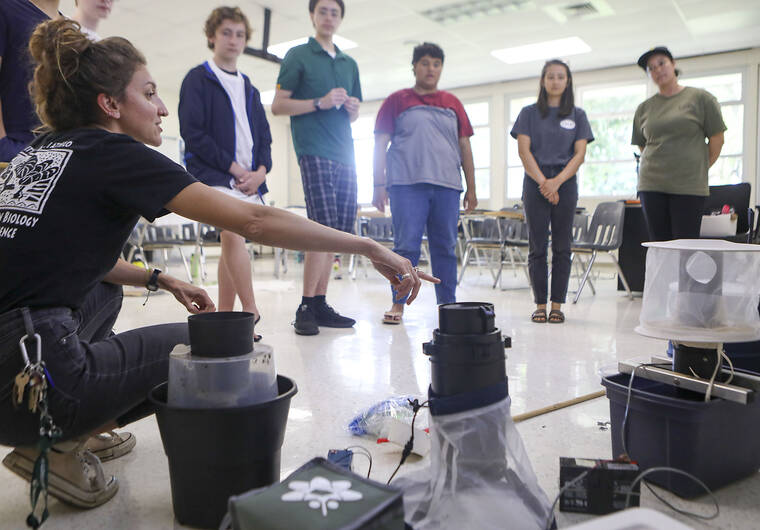TRO against release of mosquitoes has yet to impact plans for Big Isle

Kelsey Walling/Tribune-Herald Stephanie Mladinich points to different mosquito traps while teaching a group of kids during a July 8 Nextech event, 'Manu, Not Mosquitos,' at UH-Hilo.
An ongoing legal battle over a plan to import mosquitoes to Maui to protect endangered birds has not immediately affected a similar plan for the Big Island.
An ongoing legal battle over a plan to import mosquitoes to Maui to protect endangered birds has not immediately affected a similar plan for the Big Island.
In 2021, the state departments of Agriculture and Land and Natural Resources joined several other agencies — including the National Park Service, the American Bird Conservancy and more — to form “Birds, Not Mosquitoes,” an initiative to eventually import and release into the wild specially treated mosquitoes in an effort to stem the spread of avian malaria, which has devastated native bird populations.
ADVERTISING
The plan follows an approach called the Incompatible Insect Technique, whereby mosquitoes are infected with a specific strain of a bacterium called Wolbachia. Mosquitoes infected with one strain of Wolbachia become incapable of reproducing except with another host of the same strain.
By releasing a population of Wolbachia-infected mosquitoes into local mosquito populations, the two groups will attempt to reproduce but be unable to lay viable eggs before the ends of their brief lifespans, reducing the number of mosquitoes in the state. Because the imported mosquitoes are all males, the risk that they would become additional vectors for avian malaria is nonexistent — female mosquitoes are the only ones who feed on blood.
The DLNR plans to release these Wolbachia-treated mosquitoes in forests on Hawaii Island, Maui and Kauai, with environmental assessments for the projects on the latter two islands published earlier this year.
But in June, Maui nonprofit Hawaii United filed a temporary restraining order and preliminary injunction against the DLNR and its board to stop the release of the mosquitoes in East Maui.
“We don’t believe this was properly handled,” Hawaii United founder Tina Lia said Tuesday, explaining that the suit is asking the state’s First Circuit Court to require an environmental impact statement for the Maui project.
An initial hearing in First Circuit Court took place in July, with further hearings to follow later this month.
For now, the legal action shouldn’t impede the development of an environmental assessment for the release of mosquitoes on the Big Island, said Chris Farmer, Hawaii Program Director for the American Bird Conservancy.
“We’re able to keep moving for the Big Island,” Farmer said. “Obviously, we are concerned that the (Maui) case might have ramifications for work on other islands.”
But Lia said she hopes the Maui case will inspire similar legal challenges on Kauai and the Big Island. She said the project needs additional studies of potential risks and alternatives, adding that the state has downplayed the potential negative impacts.
For example, Lia said, guidelines from the U.S. Environmental Protection Agency allow for a single female mosquito to be released for every 250,000 males as an acceptable margin of error. But because the East Maui environmental assessment states that the project could release between 50 and 6,000 males per acre multiple times a week. With nearly 50,000 acres in the project area, and up to 208 million mosquitoes released per year, thousands of females could be released inadvertently.
Lia also said that a pathogen screening of the mosquitoes has not been conducted, which she said could allow the imported insects to spread foreign diseases to local mosquito populations, and from them to native species or humans.
Lia also took issue with the fact that small-scale pilot releases have already taken place on East Maui, which she said should have been more clearly disclosed to the public.
“And then there’s the experimental nature of the project — the fact that it hasn’t been done on this scale ever, or with this species ever,” Lia said.
Farmer said he was unable to comment on Lia’s objections because of the ongoing court case. However, the environmental assessment states that the chance of a female being released accidentally is 1 in 900 million, and that a single treated female released into the environment would pose no greater risk to man or beast than any other local female mosquito.
But in any case, Farmer said the plight of native birds is worse than it ever has been.
“We had a horrible summer on Kauai,” Farmer said. “The ‘akikiki (Hawaiian honeycreeper), they’re down to only five in the wild now. It’s heartbreaking.”
Farmer said the situation is more dire on the other neighbor islands than on the Big Island, owing to Hawaii Island’s higher altitude. But nonetheless, native species such as the ‘akikiki, the ‘akohekohe, the kiwikiu and the ‘akeke‘e are all at risk of going extinct in just a few years.
Email Michael Brestovansky at mbrestovansky@hawaiitribune-herald.com.


